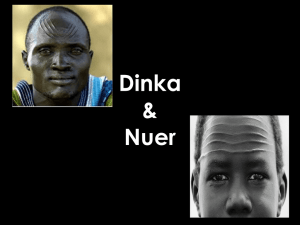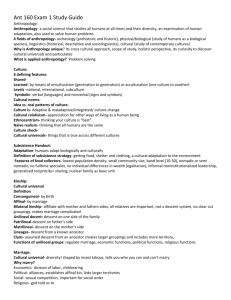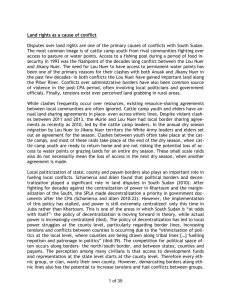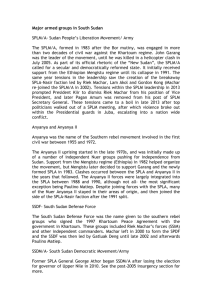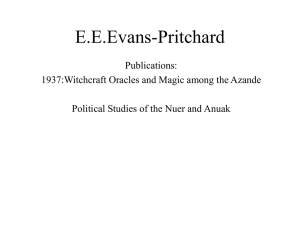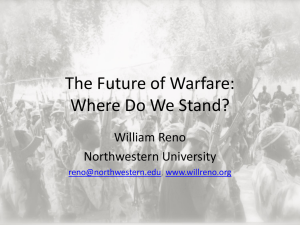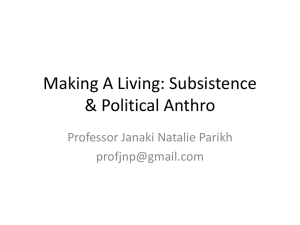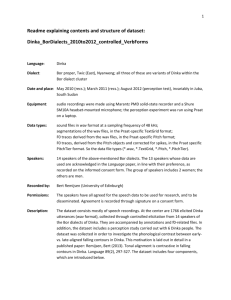this background document
advertisement
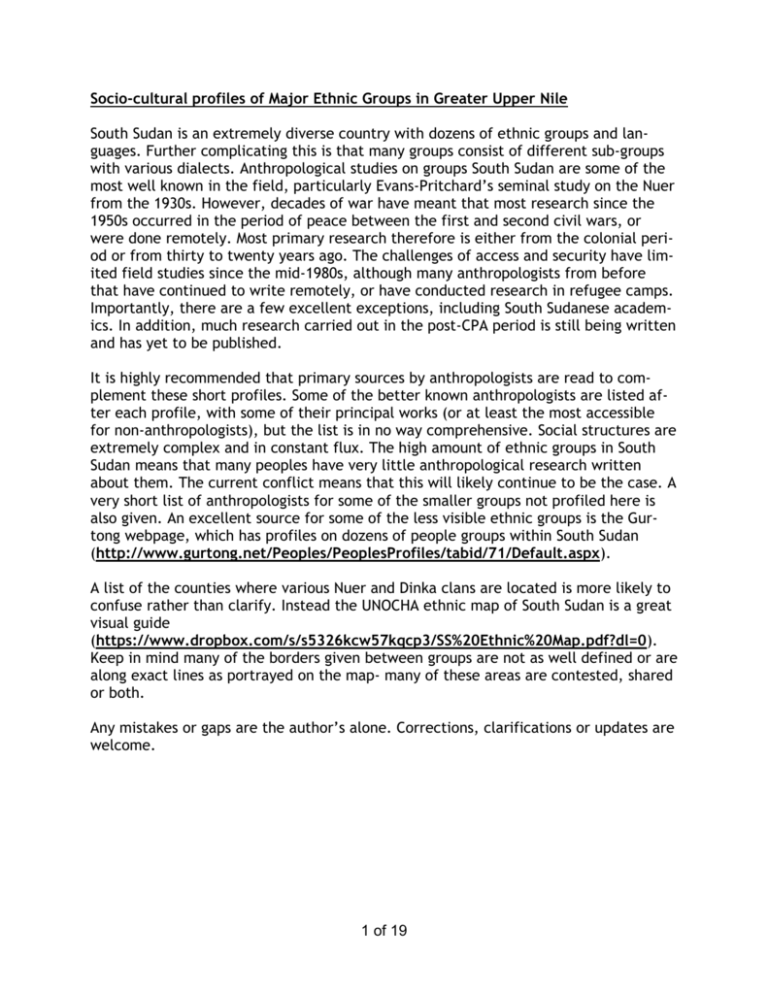
Socio-cultural profiles of Major Ethnic Groups in Greater Upper Nile South Sudan is an extremely diverse country with dozens of ethnic groups and languages. Further complicating this is that many groups consist of different sub-groups with various dialects. Anthropological studies on groups South Sudan are some of the most well known in the field, particularly Evans-Pritchard’s seminal study on the Nuer from the 1930s. However, decades of war have meant that most research since the 1950s occurred in the period of peace between the first and second civil wars, or were done remotely. Most primary research therefore is either from the colonial period or from thirty to twenty years ago. The challenges of access and security have limited field studies since the mid-1980s, although many anthropologists from before that have continued to write remotely, or have conducted research in refugee camps. Importantly, there are a few excellent exceptions, including South Sudanese academics. In addition, much research carried out in the post-CPA period is still being written and has yet to be published. It is highly recommended that primary sources by anthropologists are read to complement these short profiles. Some of the better known anthropologists are listed after each profile, with some of their principal works (or at least the most accessible for non-anthropologists), but the list is in no way comprehensive. Social structures are extremely complex and in constant flux. The high amount of ethnic groups in South Sudan means that many peoples have very little anthropological research written about them. The current conflict means that this will likely continue to be the case. A very short list of anthropologists for some of the smaller groups not profiled here is also given. An excellent source for some of the less visible ethnic groups is the Gurtong webpage, which has profiles on dozens of people groups within South Sudan (http://www.gurtong.net/Peoples/PeoplesProfiles/tabid/71/Default.aspx). A list of the counties where various Nuer and Dinka clans are located is more likely to confuse rather than clarify. Instead the UNOCHA ethnic map of South Sudan is a great visual guide (https://www.dropbox.com/s/s5326kcw57kqcp3/SS%20Ethnic%20Map.pdf?dl=0). Keep in mind many of the borders given between groups are not as well defined or are along exact lines as portrayed on the map- many of these areas are contested, shared or both. Any mistakes or gaps are the author’s alone. Corrections, clarifications or updates are welcome. 1 of 19 Ethnic group: Dinka (Jieng or Muony-jang) Language group: Nilotic Sub-groups: There are over twenty major Dinka clans. Some of these include- Rek, Ruweng, Bor, Twic, Nyarweng, Hol, Agar, Gok, Rek, Aliab, Ciec, Thoi, Luach, Ngok, Renk, Malual, Abiliang, Padeng, and Atwot. The Dinka are generally found in Greater Bahr al Ghazal, Greater Bor, and Upper Nile. See the UNOCHA ethnic map of South Sudan for locations. Related groups: Nuer Historic movement: Oral traditions dictate that the Dinka migrated from Gezira between the 14th and 16th centuries due to drought and slave raids. They moved south following the Nile into the Bahr al Ghazal region and are believed to be one of the later groups to arrive in South Sudan. Livelihoods: Agro-pastoralists The Dinka peoples are very diverse. Similar to other pastoralists in rural South Sudan and in the wider region, cattle are a central part of Dinka livelihoods and society. The Dinka primarily rely upon livestock, but are also engaged in planting (cultivation) and fishing during the dry season. The importance of fishing and agriculture on food security, however, varies between communities. Like other agro-pastoralists, many Dinka communities are reliant on moving with their cattle in the dry season (usually January to May) to the toic (swamps in the rainy season which turn into pasture in the dry season), where they set up temporary cattle camps. Here the cattle are able to access water and grazing for part of the year. Fishing is usually best in the dry season as the rivers and pools get low and fish are easier to catch. At the beginning of the rainy season (June/July) the people return to their homesteads and fields are planted. This time is often the most significant hunger period for South Sudanese agro-pastoralists, as the cattle are not producing much milk and the fields are yet to be ready for harvesting. Once the harvest is ready people celebrate. At the end of the year drums are often heard from marriage celebrations or dances. Once the dry season returns in January the cattle are taken back to the cattle camps and the cycle starts again. Historical Social Structure: 2 of 19 Before the colonial era the Dinka were an acephelous society- meaning they had no hierarchy or centralized system of coordination and control1. Instead the Dinka have been organized into a number of major inter-linked, but independent clans. The leaders that existed before the arrival of the British were either military, religious, kin group, or cattle camp elders who decided when to migrate. Loyalty and identity lied primarily with kin, not with the ethnic group as a whole. This is still the case, although political conflicts have manipulated the threat of the ‘other’ to unify groups that in the past shared little loyalty. The Dinka are incredibly diverse and the language has a number of different dialects. For example, an important system of spiritual leaders found in Bahr al Ghazal never existed among the Dinka in Jonglei (Harrigan 2012). Kinship groups are the primary means of identity and loyalty among the Dinka. According to Harrigan, Dinka kinship is most clearly delineated by the sharing of bridewealth, both in paying and receiving. The system of chiefs now found across South Sudan was created by the British colonial rule (1898-1956) as a means of civil administration (indirect rule)- primarily for the collection of taxes and solving disputes through customary courts. Chiefs were appointed to represent particular territories, and this system of local governance was reinforced by the GoSS after the CPA (through the Local Government Act in 2008). There are various levels of chiefs and although terminology varies depending on the region, the terms are usually translated to sub-chiefs/headmen, chiefs and paramount chiefs. In modern times one can recognize the hierarchy from the sashes the various chiefs wear when attending official events. Sub-chiefs, or headmen, are given black sashes, chiefs red sashes, while paramount chiefs have a number of lines on their red sashes-indicating the number of chiefs they represent. Harrigan explains that during the second civil war the chieftain system was used as a means of providing recruits as well as supplying food for the SPLA. Each sub-chief was expected to supply five recruits to the SPLA and supply one tin of maize for each family. This was later increased to three tins of maize for each family. The chiefs do not have any economic control over their community members and their primary responsibility is keeping the peace through the solving of disputes. The chiefs sit on customary courts and solve issues such as cattle theft, murder, elopement, and adultery. The courts have the same hierarchy as the chiefs, and if the judgment is appealed then cases move up the chain to higher level chiefs. Kinship groups among Dinka share cattle and food, but territory is shared among a number of family groups. These kinship groups might coordinate for political representation, collective defense of grazing land or for ceremonies, but they do not share food. Only members of a common kinship group share food and are responsible for each other. The territorial groups are called wut, which literally translates from Dinka as cattle camp. The protection and defense of the cattle in the territory is shared between the youth belonging to the family groups. 1 One major exception to this was the Ngok Dinka in Abyei. Consistent contact with the Baggara from the north led the Ngok to develop a more centralized system (Hutchinson 2012:12) 3 of 19 Relationship with SPLA and other armed elements: The common narrative is that the SPLM/A has been “Dinka dominated” from its inception in 1983. However, much like other ethnic groups the relationship between the SPLM/A and the Dinka civilian population has been complex and varied. In the beginning of the rebellion, many Dinka volunteered to join; however, the relationship between the SPLM/A and rural populations has not always been strong 2 . There were frustrations in Bahr al Ghazal in the 1980s due to their perceived exclusion from military strategy and relief support compared to other parts of the country. The recruitment of children for the Red Army was also not a popular policy, and created frustration with the leadership. While the fall of the Mengistu regime, the SPLA’s primary backer, and the subsequent 1991 split had a unifying effect, the attacks on Dinka villages by the SPLA Nasir faction at the same time led to discontent with the leadership for not being able to provide security. The consequent arming of the Dinka youth in Bahr al Ghazal, also known as Gelweng, led to the use of armed Dinka civilians as proxy militias for the SPLA. The clashes between the two factions, and the arming of civilian militias (i.e. gelweng, see White Army, Gelweng and Titweng section), were causing resentment among the civilians caught in the middle as targets. Furthermore after the 1999 Wunlit peace agreement the SPLA decided to disarm the gelweng to reduce the internal clashes that were occurring. The brutality of the disarmament process also resulted in violent clashes between the youth and SPLA, and created strong grievances against the movement. Key individuals: The late John Garang Mabior Salva Kiir Kuol Manyang Recommended readings: Deng, Francis Mading. 1972. The Dinka of the Sudan. Waveland Press Inc. Illinois. Deng, Luka Biong. 2010. “Social Capital and Civil War: The Dinka Communities in Sudan’s Civil War.” African Affairs, 109/435, 231-250. (https://www.dropbox.com/s/w6jn4eprzkra4a8/Deng%20-%202010%20%20Social%20capital%20and%20civil%20war%20The%20Dinka%20communities%20in%20S udan%27s%20civil%20war%282%29.pdf?dl=0) 2 For more about the complexity of Dinka civilian relations with the SPLA in Lakes State read Leonardi, Cherry. 2007. “‘Liberation’ or Capture: Youth in Between ‘Hakuma’, and ‘Home’ During Civil War and It’s Aftermath in Southern Sudan.” African Affairs, 106/424, 391-412. 4 of 19 Harrigan, Simon. “Background paper for Bor, Twic, Ghol and Nyaraweng Dinka” presented at AECOM conference, Nairobi March 2012 (https://db.tt/cusHiNtO) Jok, M.J. and S. Hutchinson. 1999. “Sudan’s Prolonged Second Civil War and the Militarization of Nuer and Dinka Ethnic Identities.” African Studies Review 42(2): 125-45. (https://db.tt/nkMlG74a) Leinhardt, Godfrey. 1961. Divinity and Experience: The Religion of the Dinka. Oxford Clarendon Press. Ethnic group: Nuer (Nei ti naadth) Language group: Nilotic Sub-groups (major clans): Some of the major clans among the Nuer include the Lou, Jikany, Gawaar, Bul, Lek, Jegai, Adok, Nyong, Ador, Thiang and Lak. The Nuer are generally found in Greater Upper Nile (Unity, Jonglei and Upper Nile states). See the UNOCHA ethnic map of South Sudan for locations. Related groups: Dinka Historic movement: According to oral traditions the Nuer migrated south from Kordofan to Bahr al Ghazal around 1700 due to drought. In response to slave raids by the Baggara Arabs in the 18th century the Nuer carried out a mass migration to the east across the Nile (Hutchinson 2012). The expansion in the 19th century by the Nuer was one of the largest expansions in Africa at the time. The Nuer moved into Dinka and Anuak lands and assimilated some people while pushing others to migrate. By the end of the century the Nuer had reached all the way to Ethiopia and their territory expanded between three and four times what it was previously. While the Nuer did use violence to expand their territory, marriage and adoption were often used as means of assimilating new groups. Hutchinson explains that many Nuer men would marry their daughters to Dinka and Anuak men as a means of assimilating them (ibid). Those paying bridewealth did not just owe cattle, but also owed cooperation and respect towards their in-laws for as much as eight generations afterwards. This expanded family groups and loyalties and eventually sons or grandsons would break away to form his own family group and village. When the British definitively defeated the Lou Nuer in 1929-1930, the Nuer expansion diminished but did not stop entirely (Hutchinson 2012). According to Nuer oral sources and archives, Lou and Jikany Nuer both continued to expand to the east and attempted to buy land from Anuak and Murle. The Murle took the land back in the 1950s, while the Anuak sold land to the Nuer south of Akobo. In 1982 this agreement came to a head and clashes broke out between Anuak and Nuer over the land rights (ibid). 5 of 19 Hutchinson believes the disagreement might have sprung out of differing opinions on what the Nuer bought- either permanent land ownership or temporary access for grazing (ibid). The Nuer pushed the Anuak out of Akobo town and the Anuak are now primarily in Ethiopia, Pochalla and eastern Akobo county. The movement of thousands of South Sudanese to Ethiopia in the 1980s expanded Nuer territory in Gambella, again at the expense of the Anuak. Further clashes in Akobo in 2013 escalated tensions again after the death of an Anuak chief in Akobo who was calling for the Lou to give Akobo back to the Anuak. Livelihood: Agro-pastoralists The Nuer share a similar livelihood cycle with the Dinka (see the Dinka livelihood section for an explanation of the annual cycle). The Nuer dry season migratory patterns are too complex and vast to list here. However, like most dry season migratory patterns the cattle are taken to the toic (pastures), nearby the closest permanent or semi-permanent body of water, usually rivers. See map in index of migratory patterns. Historical Social Structure: Much like the Dinka, the Nuer ethnic group were historically acephelous and did not have a centralized system of political control before the arrival of the British. Instead the Nuer are divided into between eleven and thirteen sub-groups or clans. Within these clans there are family groupings interlinked through either marriage or descent. In reality this means that loyalty and identity lies with direct family primarily, and then with more extended family units dependent on outside threats. Hutchinson explains it as “brothers should unite against cousins, unless faced with a broader threat, whereupon cousins should all unite to face their common enemy” (2012:13). The consequence of this is very fluid alliances and loyalties outside the small familial units. The internal Nuer wars of the 1990s and early 2000 can be better understood through this lens. A perceived outside threat to all Nuer will unify them, but primary loyalties ultimately lie with small family units, not the ethnic group as a whole or even the major clans. In pre-colonial time, Nuer society did have particular individuals responsible for spiritual and ritual aspects of society, such as earth priests and prophets, but they did not have a political role. Despite this prophets did have many followers and the songs (prophecies) of the most influential, such as Ngundeng Bong (1846-1906), still hold significant sway over much of the Nuer population (Johnson 1994). The spiritual leaders held influence due to their perceived powers to bless or curse and foresee the future. Current Nuer prophets are still believed to hold such powers and people go to them for blessings and direction. The British undermined the Nuer prophets as they were perceived as threats to colonial dominance and instead imposed a chieftain structure. Initially weak the government system of chiefs soon became adopted and assimilated into Nuer society. 6 of 19 The authority of government chiefs was directly affected by the two civil wars. As explained in the Dinka section, the SPLA, and the later breakaway factions, initially used the chief system as a means for recruiting as well as supporting their troops through food and other resources. However, high level chiefs (not seen as sympathetic to the political cause) were often targeted during the war years, either by Khartoum or by opposing factions of the SPLA. The current relationship between chiefs, the government, and the opposition varies from county to county. It is highly likely both sides in the current conflict are relying on the chieftain system in many of the same ways they did in the 1980s and 1990s – i.e. as sources of recruitment as well as economic support – albeit not always voluntarily. From quite early on the SPLA-IO has worked with Nuer prophets, such as Dak Kueth, in mobilizating and motivating the White Army. Relationship with SPLM/A: The Nuer relationship with the SPLM/A is extremely complex. The below discussion will focus on Riek Machar and his split from the mainstream SPLM/A to create his own movement in 1991 (SPLM Nasir), his rejoining of the SPLM/A in 2002, and then the most recent creation of his SPLM/A in Opposition (IO) after the violence broke in Juba in December 2013. The effects of the 1991 split are analyzed more closely in the militarization section. However, while Machar has received the most attention among the Nuer leaders, his political agenda has not necessarily been supported across the Nuer population or leadership. Machar’s involvement in arming and directing Nuer civilians who targeted civilians in Garang’s homeland in the notorious “Bor Massacre” still defines the political narrative surrounding him. While Machar publicly apologized for his involvement in the Bor Massacre in 2013, in the current conflict the government has also used this event as a means of discrediting him. Importantly, the manipulation of ethnicity by Machar and other military leaders in the past twenty years has clouded the nuances regarding Nuer support for Machar’s positions. Common narratives in the media oversimplify extremely complex realities. It must be remembered that when Machar first split from the SPLM/A in 1991 to form the SPLA Nasir faction, it was not a pure Nuer movement, but Shilluk, some Dinka and other ethnic groups were also represented. Meanwhile, some Nuer leaders remained loyal to the mainstream SPLM/A. The consequent manipulation of ethnicity and targeting of civilians by both sides changed the conflict dynamics from a political and ideological contest to an ethnic one, but it did not start out as an ethnic dispute. Similarly, not only Machar and his Nuer supporters were frustrated with the current leadership within the SPLM: Dinka and Shilluk leaders who had been vocal in their criticism against the government were also arrested in December 2013. Although they have not supported the armed movement of Machar, they are advocating for reform within the party (commonly referred to as the Third Bloc). Importantly a significant portion of south on south violence in the civil war was actually between Nuer factions in the 1990s. Many Nuer did not support Machar’s decisions to sign an agreement with Khartoum (1997), while others contested him for power. 7 of 19 Primary loyalty among many Nuer soldiers lied with certain commanders, often based on kinship, not with Machar himself. The targeting of Nuer civilians in Juba in December 2013 acted as a means of mobilizing Nuer support for the SPLM/A-IO. As Hutchinson explained, among the Nuer brothers will fight brothers unless they have a problem with the cousins - then they will unite against their common enemy. The killings of Nuer in Juba in December 2013 by forces of the government united the Nuer together. Importantly though, the unity is based on the perceived threat against all the Nuer, not on the leadership skills of Machar or the desire to support any particular political agenda. The civilians who are fighting on behalf of the opposition prefer to fight in parallel to the military structures (Breidlid and Arensen 2014). Attempts by the opposition leadership to assimilate them will be very challenging. In addition the other Nuer commanders, such as Peter Gadet, are not likely to support Machar’s political agenda or possibly even his military leadership. If the current dynamics follows a similar pattern to the 1990s, Machar will struggle to keep control over the various commanders and armed civilians. The longer the current conflict goes on the higher the chance that fragmentations among the opposition will occur as commanders vie for power and soldiers and armed civilians loyalty to Machar is challenged (ibid). Key individuals: Riek Machar Taban Deng Gai Peter Gadet Breidlid, Ingrid Marie & Michael J. Arensen. 2014. “Demystifying the White Army: Nuer armed civilians’ involvement in the South Sudanese Crisis.” Conflict Trends Issue 3, 2014. 32-38. Evans-Pritchard, E. 1940. The Nuer: A Description of the Modes of Livelihood and Political Intervention of a Nilotic People. Oxford: Oxford University Press. _____________. 1951. Kinship and Marriage among the Nuer. Oxford: Clarendon Press. Johnson, Douglas. 2009. “The Nuer Civil Wars.” In Changing Identifications and Alliances in North-East Africa: Sudan, Uganda, and the Ethiopia-Sudan borderlands. Gunther Schlee and Elizabeth Watson (eds). New York: Berghahn Books. Johnson, Douglas. 1994. Nuer Prophets: A History of Prophecy from the Upper Nile in the Nineteenth and Twentieth Centuries. Oxford University Press. Jok, M.J. and S. Hutchinson. 1999. “Sudan’s Prolonged Second Civil War and the Mili8 of 19 tarization of Nuer and Dinka Ethnic Identities.” African Studies Review 42(2): 125-45. (https://db.tt/nkMlG74a) Hutchinson, Sharon. 1996. Nuer Dilemmas: Coping with Money, War, and the State. Berkeley: University of California Press. _____________. 2012. “A Guide to the Nuer of Jonglei State, Part One: Nuer and Dinka patterns of migration and settlement” presented at AECOM Jonglei conference, Nairobi March 2012 (https://db.tt/yaFlbZjn) Ethnic group: Chollo (Shilluk3) Language group: Nilotic The Chollo are generally based in Upper Nile state around Malakal and the White Nile and Sobat Rivers. Related groups: Anuak, Pari, Luo Historic movement: According to oral tradition the Chollo originally migrated from Bahr al Ghazal around 500 years ago. The founder of the Chollo, Nyikang, separated from other Luo groups and led his people down the White Nile. They arrived at the current location around 1500 AD and decided to settle around Malakal. Livelihood: Agrarian The Chollo livelihood primarily rely upon fishing and agriculture. Livestock are highly valued, but the Chollo are not as dependent upon cattle for food relative to other groups. In the dry season the livestock do not need to migrate far away into other territories. Many cattle camps were actually on islands in the rivers along which the Chollo kingdom was settled4. Historical Social Structure: Unlike most the ethnic groups in South Sudan, the Chollo have a very centralized system of governance. After settling at the junction of the Nile and Sobat rivers around 1500 AD, the Chollo fought wars with the Dinka from 1600-1650. These wars led to the establishment of the Chollo kingdom. The Chollo have a monarchy under a king (reth) 3 The Chollo are commonly referred to as Shilluk although that is actually an incorrect pronounciation from the past. As a result the correct name, Chollo, will be used instead. 4 Literature does not state if this is still the case. 9 of 19 who is believed to be divine. He is selected from among the sons of the current king. It is the duty of the reth to perform sacrifices to the original leader, Nyikang, and ensure his shrines are maintained. The kingdom was divided into two political districts (north and south) and fifteen provinces. Each province was led by a paramount chief who reported to the king. The provinces were divided into eleven settlements, each which were led by a chief. The king still plays a major role in Chollo life today and is responsible for collecting taxes and solving local disputes. The Local Government Act5 gave the king formal authority over civil administration of the Chollo areas. While the king is expected to be politically neutral in his role as the head of the kingdom he has historically been close to the former SPLM Secretary General Pagan Amum, and been the rival of another Chollo politician Lam Akol (head of the breakaway SPLM DC party- see below for more details). Relationship with SPLA and other armed elements: Like many other groups the relationship between the Chollo and the SPLA in the past few decades is mixed. The Chollo community has been divided between the political leaders Lam Akol and Pagan Amum. Akol was a high level commander in the SPLA movement but left the movement with Machar and others to form the SPLA-Nasir faction in 1991. He then left Machar to create SPLA-United in 1993 and signed an agreement with Khartoum in 1997.6 He stayed aligned to the Khartoum government until 2003, when he rejoined the SPLM/A. After the signing of the CPA Akol was appointed Minister of Foreign Affairs between 2005 and 2007, but then left the SPLM/A again. He founded the SPLM Democratic Change (DC) movement in 2009. While some traditional Chollo leaders supported him, others supported the SPLM party instead, including the king (reth) and SPLM Secretary General Pagan Amum. Akol ran against Salva Kiir for the presidency in 2010, to much chagrin from within the SPLM. The SPLM DC party has faced major challenges from the SPLM since its inception. Due to Lam Akol’s past alliances with Khartoum, the party has been accused of being a branch of the NCP, and Akol’s call for unity with the north reinforced this assumption. While the SPLM attempted to ban SPLM DC from taking part in the elections (2010) the courts rejected the idea and Lam Akol competed against Salva Kiir for the presidency. While Akol lost, four SPLM DC parliamentary candidates won seats in the election. The SPLA refused to accept the results and arrested the candidates in May 2010. The candidates were restored at the end of August 2010 after the Legislative Assem- 5 http://mlgi.org.za/resources/local-government-database/by-country/sudan/sub-nationallegislation/The%20Local%20Government%20Act%202009.pdf 6 SPLA-United was initially the new name for SPLA-Nasir in which both Akol and Machar were leaders. Machar then changed his movement to SSIM (South Sudan Independence Movement) and Lam Akol kept the United named for his own separate movement. 10 of 19 bly voted to give them back their immunity as elected members. However, by this time violence had already erupted in Upper Nile. A barge attack by unknown persons was blamed on supporters of SPLM DC, prompting a quick deployment of an SPLA division to the area to “clear the area of the Lam Akol militia.” Soon followed reports of human rights abuses against civilians by the SPLA, who allegedly did not differentiate between the militia members and civilians from the community. After a failed ceasefire, fighting erupted in March 2011 which saw Malakal the target of an attack by opposition forces. Although repelled, the operation to clear the town by the SPLA led to serious accusations of more human rights abuses by the military against Chollo civilians. One of the Chollo commanders involved in the SSDM/A opposition movement in the area, Johnson Olony, accepted an amnesty offer by President Kiir in September 2013 after he received a pardon from the king for killing a Chollo chief. After violence broke out in December 2013 Olony and his men helped the SPLA take control of Fashoda County and later in January helped the SPLA take back Malakal from opposition forces. Because of the support of Olony’s forces to the government/SPLA, Chollo civilians’ have become targets for the SPLM/A IO forces and allied civilian fighters. Meanwhile, as elsewhere in the country, Nuer civilians in and around Malakal have been targeted by the SPLA. While the association with Lam Akol led to the targeting of Chollo civilians by the SPLA in 2010, many Chollo have also supported the SPLM mainstream. As stated, the king has politically opposed Lam Akol and has maintained close ties with Pagan Amum, a high level Chollo politician who, until recently, was within the SPLM. However, in response to his avocation for SPLM reform and decision to run for the upcoming Presidential elections, President Kiir dismissed Amum from his position as the SPLM Secretary General in 2013. As this was a clear violation of the party constitution, Amum took the case to court, but was arrested after the violence broke out in December 2013, accused of plotting a failed coup attempt against the President. Pagan was eventually released and is now one of the leaders within the “third bloc”, who are not aligned with either Machar or President Kiir. Meanwhile, as an illustration of constantly shifting alliances in South Sudanese politics, Lam Akol has been involved in the talks in Addis as part of the government delegation, despite being the leader of an opposition party. In conclusion, the Chollo relationship with the SPLA varies within the community and frequently changes. Historically the Chollo have had more tension with the Dinka than the Nuer due to disputes over land. But currently Olony’s forces are supporting the SPLA against the SPLA/M IO in Malakal, which has led to Nuer retaliation against Chollo communities. On the other hand Pagan Amum, who since the civil war has been a main propagator of the SPLM, is now opposing the president, but is not supporting Machar. Lam Akol was a main opponent of the government, but since December 2013 is again involved with the government. The constantly shifting alliances show a desperate attempt by both sides to find support and allies. It is highly likely the Chollo 11 of 19 civilians primary concern is with protecting their community and do not support the political agenda of either party at this time. Key individuals: Lam Akol Pagan Amum Peter Nyaba Johnson Olony Evans-Pritchard, E.E. 1948. The Divine Kingship of the Shilluk of the Nilotic Sudan. Cambridge University Press. Westermann, Deidrich. 2009. The Shilluk People, their Language and Folklore. Michigan University Press. (reprint of a book from before 1923, which was very well known in its era- not sure if it holds up well now) Ethnic group: Murle Language group: Surmic Sub-groups: There are four clans- Tangajon, Ngaroti, Kelenya, Nginvach & Lowland Murle and Highland Murle The Murle are all based in the Greater Pibor Administrative Area which includes the former counties of Pochalla and Pibor. The Murle are all found in the former county of Pibor. There are four clans, or drumships, within the Murle that all Murle people are part of. These are not as important as B.A. Lewis describes in his work, but especially among the red chiefs the drumships are part of Murle identity. Of the four drumships there are two major ones- Tangajon and Ngaroti- and two minor ones- Kelenya and Nginvach. Although not actual sub-groups, both in recent years and in the past there has been discussion around the differences between the highland Murle of Boma and the lowland Murle of Pibor. The main differences between the groups exist around livelihoods, with the lowland Murle relying primarily upon cattle and pastoralism. In contrast the highland Murle are dependent upon agriculture. This is due to the existence of livestock diseases around Boma, which make cattle raising untenable. The highland Murle have historically been called “Ngalam” by the lowland Murle, which literally translates as sugar-ants, implying they work in the dirt and lack the prestige of cattle ownership. In recent years the SSDM Cobra Faction of David Yau Yau has escalated tension between the SPLA and the Murle community, which has consequently seen the highland Murle distance themselves more from his movement, and therefore the lowland Murle as a whole. This has led to political leaders and chiefs from Boma embrac12 of 19 ing the ‘Ngalam’ identity, although this is perceived by many as a mechanism to protect their community from targeting by the military. The recently created Greater Pibor Administrative Area (GPAA) will introduce new counties, including Boma, which could further entrench differences depending on management. However, despite differences the highland Murle still identify themselves as members of the Murle group as a whole, and very strong kinship ties exist due to frequent inter-marriage and movement between the two areas. Historic movement: The Murle claim to have always lived in the Pibor County area, but academics believe they originated from Southwest Ethiopia. The historic migration into Pibor County occurred from Eastern Equatoria, where Boma was settled first and then the Murle continued to migrate northwest. As with many ethnic groups the arrival of the colonial powers put a halt to Murle expansion to the west towards Bor. Nuer claim that the Murle took Nuer grazing land in the 1960s and 1970s along the Nanaam River in the northwest of Pibor County, but major expansion halted about 100 years ago. Livelihood: Agro-pastoralists Like many of their neighbors the lowland Murle are agro-pastoralists and primarily depend on their livestock, which they migrate with to the toic and cattle camps in the dry season. In addition they engage in seasonal planting along rivers, fishing and (historically) hunting of the white-eared kob migration. However, around the beginning of the rainy season, when the cattle have stopped producing most of the milk, fishing is exhausted and food storage is beginning to run low, the Murle faces an annual hunger period between June and July. After the return of the rains in May or June planting is carried out for the next harvest, but food is still a major issue as the cattle have dried up and the harvest has yet to come. Once the harvest is ready, the new cattle are born and the cows begin to produce milk again, the annual cycle begins again. This carefully balanced lifestyle is easily affected by external factors, such as conflict, raids and droughts. Missed (lost?) planting seasons in 2011-2013 among the Murle due to conflict and raids significantly reduced their ability to cope for additional shocks. The Murle in Boma do not seasonally migrate, as they rely primarily upon agriculture. While less food insecure than the lowland Murle, the highland Murle also missed planting season in 2013 due to conflict between SSDM-CF and the SPLA. Stability and secure planting seasons are key for 2014 if the Murle are going to improve their food security. Historical Social Structure: a. Age-sets The key structures in Murle society are the age-sets. Male youth from a certain age segment become members of an age-set and this is an identifier throughout life. Each 13 of 19 age-set has an animal, color scheme and a scarring pattern particular to them. Once you learn these it is often easy to tell which age-set people belong to. Women wear the colors or get the markings of their husband, and small girls wear the color of their father. Age-sets last for life, but it is when the men are young and single that they matter most. The men want to fight and prove themselves, and through this get access to adolescent women at the dances they hold. There tend to be two active age-sets- the dominant one which holds dances and who are most responsible for defense and protection of the tribe (currently the Botonya), and the one below them who are trying to establish themselves as a full-fledged age-set (currently the Lango). Within each age-set there is no clear structure or hierarchy of leadership. Youth either look to those who are from a red chief family, and therefore have the ability to curse, or youth with proven ability in terms of speaking, hunting or fighting. Raids are not planned or known by an entire age-set, but by geographical proximity and personal relationships. This is also apparent by the number of Murle youth usually involved in raids, between five and twenty. Murle Age-sets in descending order (oldest to youngest): Mara Dorongwa Muden Titti Botonya Lango b. Red Chiefs One of the original studies of the Murle, by B.A. Lewis, focused on the existence of four drumships, led by red chiefs. More recent academics believe these structures were exaggerated in importance, but they still play a role in Murle society. The role of red chief holds the most influence among the age-sets and Murle community. The Red Chief’s power is based on his religious authority, in particular the ability to curse people. There are four clans, two major ones- Tangajon and Ngaroti- and two minor ones- Kelenya and Nginvach. There are “leaders” of each clan amongst the red chiefs, but they are purely the eldest male present from the family at a time. Any male members of the red chief families have the power to curse, which means each age-set has descendants of the red chief clans who hold some level of influence. The role of red-chiefs has decreased in recent decades due to increasing external influences such as the political economy of the civil war. In addition since red chiefs identity is passed down patrilineal lines (from fathers to sons), the high number of red chiefs in modern Murle society seems to have reduced their influence relative to the past. Relationship with SPLA and other armed elements: 14 of 19 The Murle have had a poor relationship with the SPLM/A in the last couple decades. In the beginning of the southern rebellion members (including commanders) of the Murle were involved, as illustrated by the army mutiny in Pibor in 1983, along with Bor and Pochalla. Boma was one of the first SPLA bases, and it was never lost to the north during the Second Civil War. However, a few years after the start of the movement a high profile Murle leader was killed in Ethiopia by other members of the SPLA. While the causes of his death are debated, his death led to a major reduction of support for the movement among the Murle population, who perceived a bias against them and other minority groups in the fledgling movement. Consequently a Murle leader (Sultan and Red Chief), Ismael Konyi, looked to Khartoum for support in arming his local militia, Pibor Defense Force (PDF) in order to protect the Murle community against the SPLA. Despite the use of Boma as a major base throughout the war, the SPLA were never able to recapture Pibor after Konyi’s PDF captured it in 1992. The historic ties with the government in Khartoum, and their resistance against the SPLA during the war, have increased animosity between the Murle and their historic ‘rivals’ of the Nuer and Dinka. Despite this, it must be remembered that many Murle remained loyal to the SPLM/A and some rose to the rank of Brigadier General. Meanwhile the highland Murle in Boma hosted one of the main SPLA bases throughout the war, although like in the rest of the country tension existed between the soldiers and the community ‘supporting’ (hosting) them. In more recent years (post-CPA) the SSDF Cobra Faction, led by David Yau Yau, has dominated the headlines on Pibor. David Yau Yau first rebelled after losing in the 2010 elections in Pibor County. At the time it was not a major movement and a peace agreement was signed with the government in June 2011. However, after the forced disarmament of the Murle by the SPLA in early 2012 Yau Yau went back to the bush. The general frustration with the government among the Murle youth after the disarmament prompted a mass recruitment into his forces. SPLA positions were targeted, culminating in the loss of Boma (when?). The SPLA, led by Peter Gadet, carried out a counter-insurgency campaign in which they recaptured Boma, but they could not defeat the movement entirely and the campaign further damaged relations with the civilian Murle population. A peace deal was finally reached in 2014 thanks to the work of the church as a mediator and the nation-wide conflict between the government and SPLA-IO. The government needed to ensure the Murle did not join the opposition and the Murle benefitted from the newly created Greater Pibor Administrative Area (GPAA) led by David Yau Yau. While the deal is politically convenient for both the government and Yau Yau for the time being, it remains fragile. Key Murle individuals: Ismael Konyi Kennedy Gain David Yau Yau Baba Medan 15 of 19 Further Reading: Andretta, E. 1985. “A Reconsideration of the Basis of Group Cohesion among the Murle of the Southern Sudan.” University Microfilms International. Arensen, Jonathan E. 2012. “Murle Ecology” presented at AECOM Jonglei conference, Nairobi March (https://db.tt/HRZgPkWZ) ________. 2012. “Murle History” presented at AECOM Jonglei conference, Nairobi March (https://db.tt/b8CgJ3u6) ________. 2012. “Murle Political Systems and Age-sets” presented at AECOM Jonglei conference, Nairobi March (https://db.tt/JdrQQYAm) ________. 1992. Mice are Men: Language and Society among the Murle of Sudan. Summer Institute of Linguistics. Lewis, B.A. 1972. The Murle: Red Chiefs and Black Commoners. Oxford Clarendon Press. Ethnic group: Anuak (Anyuak, Anywaa) Language group: Nilotic (Luo) The Anuak are now mostly found in East Akobo and Pochalla in South Sudan and Gambella in Ethiopia. Related groups: Chollo Historic movement: The Anuak share an oral history with the Chollo, but have different names for the leaders. The Chollo name of Nyikango, who led the Chollo people up the Nile to settle in Malakal, is instead named Akango in Anuak. His brother, Gilo, continued to migrate up the Sobat River and this migration is the start of the Anuak. The Anuak originally settled in the Baro, Sobat and Gilo river areas, but were pushed further east by the Nuer migration in the 19th century. It is said that Gilo’s grandson, Cuwai, was the first Anuak king and his descendants are the Anuak people. Livelihood: Agrarian The Anuak are now primarily agrarian and rely on cultivation, not livestock. The king even reduced the bridewealth price of Anuak women as a means of reducing the numbers of livestock they held, which reduced them as targets of raids by neighboring 16 of 19 Murle and Nuer. As a result the Anuak do not have a seasonal migratory route like their pastoralist neighbors. Historical Social Structure: The Anuak also have a kingdom like the Chollo who they broke away from hundreds of years ago. The system of rule was through a federation of villages, which had their own headmen and court system. These headmen are under the sub-chiefs who report to the independent king (nyie), who is above all Anuak, much like the Chollo king. Historically the villages were constantly competing for the title of nyie, but this was stopped by the British. The colonial powers were tired of the feuding and selected one family to hold the title of ‘king of kings’ in a copy of the feudal system in Ethiopia at the time. The Nyie Agada Akway and his descendants were made the permanent holders of the title. Relationship with SPLA and other armed elements: As stated in the Nuer section the Anuak lost land in the 19th century due to the Nuer expansion and then again in the 1980s when the Nuer moved further into Ethiopia with the SPLA bases there. In the 1980s the Anuak also lost land in Akobo to the Lou Nuer and continually are pushed further east. The Anuak are now also losing land on the Ethiopian side of the border in Gambella. With all land being nationalized the Ethiopian government is distributing it to major agricultural corporations and forcing the Anuak out. This is part of the reason for an Anuak rebellion against the Ethiopian government in the last few years. The further loss of traditional Anuak land on the Ethiopian side of the border has also emboldened them to push back on their land rights against the Lou Nuer in Akobo. Those living in diaspora are calling for the restoration of traditional land to the Anuak and the armed movement in Gambella has received an inflow of arms, presumably from the Eritreans. In 2013 a Lou Nuer man who was found dead near Akobo led Lou Nuer youth to retaliate against an Anuak chief in Akobo County who has called for the return of Anuak to their homeland in Akobo. His consequent death at the hands of the Nuer youth escalated tensions between the Nuer and Anuak in Akobo and the Anuak moved further east towards Pochalla. In December 2013 when the fighting broke out in Juba, the Nuer SPLA were pushed out of Pochalla to Akobo by the Dinka soldiers supported by the Anuak population. Like in much of the country, historical local disputes, such as those between the Lou Nuer and Anuak, are likely the primary reason the Anuak have sided with the government in the current conflict. Key individuals: David Okwier Further Reading: Evans-Pritchard 17 of 19 Feyissa, Dereje. 2011. Playing Different Games: the paradox of Anywaa and Nuer Identification Strategies in the Gambella region. New York: Berghahn Books. _____________. 2009. “Conflict and Identity Politics: The Case of Anywaa-Nuer Relations in Gambela, Western Ethiopia.” In Changing Identifications and Alliances in North-East Africa: Sudan, Uganda, and the Ethiopia-Sudan borderlands. Gunther Schlee and Elizabeth Watson (eds). New York: Berghahn Books. Kurimoto, E. 2001. “Capturing Modernity among the Anywaa of Western Ethiopia.” In Rewriting Africa: Toward Renaissance or Collapse. E. Kurimoto (ed.). Osaka: Japan Centre for Area Studies. ___________. 1992. “Natives and Outsiders: The Historical Experience of the Anywaa of Western Ethiopia.” Journal of Asian and African Studies 43: 1-43. Perner, Conradin (‘Kuacakuoro’) Ethnic group: Maban Language Group: Nilotic Sub-groups: The Maban are frequently grouped as part of the greater Burun peoples, which consist of several other independent groups- Uduk, Jumjum, Ragreg, Ganza, Mopo, Mayak, Mabano, and Buldid. These groups are spread across the Sudanese-South Sudanese border between Southern Blue Nile and Upper Nile. Related groups: Shilluk Historical Migratory patterns: Another Luo group the Maban are said to have separated from the Chollo at Soba (near Khartoum). It is believed this occurred after the fall of the Makkura Kingdom. The Maban arrived at their location between the east bank of the Nile and the Ethiopian highlands via the Baro River. Livelihood: Agrarian Although the Maban own livestock their primary means of livelihoods is cultivation. Like the other agrarian groups in South Sudan they do not rely on seasonal migration in the dry season. Historical Social Structure: Like most of the Nilotic groups the Maban did not have a centralized system of administration or control until the arrival and imposition of the British chieftain system. Their split with the Chollo occurred before the latters creation of a centralized sys18 of 19 tem (i.e kingdom) and therefore the Maban do not share it. Spiritual leaders had influence historically, but no political influence. Relationship with SPLA and other armed groups: The recent appearance of the Mabanese Defense Forces (MDF) has brought the Maban into the current conflict. The MDF has targeted Nuer NGO staff in an apparent retaliation for losses from clashes against SPLA-IO in July. Anthropologists of additional people groups not profiled above: Atuot people- John Burton Bari, Tenet and Lutuho peoples- Simon Simonse Didinga people- J.H. Driberg Mundari people- Jean Buxton Pari people- Eisei Kurimoto Uduk people- Wendy James 19 of 19
